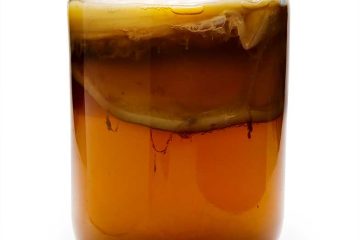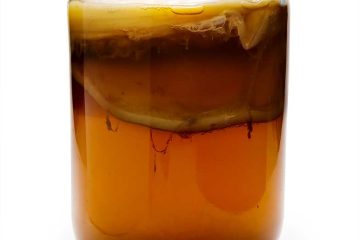Delicious and Easy Kombucha Tea Recipe for Beginners

Delicious and Easy Kombucha Tea Recipe for Beginners
Delicious and Easy Kombucha Tea Recipe for Beginners
Kombucha tea, often referred to as the “immortal health elixir,” has been gaining popularity in recent years for its potential health benefits and delicious taste. This fermented tea is rich in probiotics and antioxidants, making it a popular choice for those looking to improve their gut health and overall well-being.
Making your own kombucha tea at home is not only easy but also incredibly rewarding. With just a few simple ingredients and some patience, you can create a batch of delicious and nutritious kombucha tea that you can enjoy for weeks to come. In this article, we will provide a step-by-step guide to making your own kombucha tea at home, perfect for beginners who want to explore the world of fermentation.
What is Kombucha Tea?
Kombucha is a type of fermented tea that is made by combining sweetened tea with a symbiotic culture of bacteria and yeast, often referred to as a SCOBY. The fermentation process that takes place over a period of 7-14 days transforms the sweet tea into a tangy, fizzy beverage that is packed with probiotics and beneficial acids.
The origins of kombucha are believed to date back to ancient China, where it was highly regarded for its healing properties. Today, kombucha has become a popular beverage worldwide, celebrated for its potential health benefits and wide range of flavors.
Health Benefits of Kombucha Tea
Kombucha tea is often praised for its potential health benefits, which are largely attributed to its probiotic content and antioxidants. Probiotics are beneficial bacteria that are essential for maintaining a healthy gut microbiome, which in turn can support digestive health, a strong immune system, and even mental well-being.
In addition to probiotics, kombucha tea also contains a range of antioxidants, which can help combat oxidative stress and inflammation in the body. These antioxidants, along with a variety of vitamins and minerals found in kombucha, can support overall health and well-being.
Furthermore, kombucha may also have antimicrobial properties, which can help the body fight off harmful bacteria and infections. While more research is needed to fully understand the potential health benefits of kombucha, many people enjoy incorporating it into their wellness routines for its potential gut-healing properties and refreshing taste.
The Kombucha Brewing Process
Making your own kombucha tea at home is a simple process that requires just a few key ingredients and some patience. Here’s a step-by-step guide to making delicious and easy kombucha tea for beginners:
Ingredients:
• 1 SCOBY (symbiotic culture of bacteria and yeast)
• ½ cup of sugar
• 4-6 bags of black or green tea
• 1 gallon of water
• 1-2 cups of starter tea (previously brewed kombucha)
Equipment:
• Large glass jar/container
• Cloth or paper towel
• Rubber band
• pH strips
• Funnel
• Glass bottles with tight-fitting lids
Step 1: Prepare the Sweet Tea Base
To begin, bring the water to a boil in a large pot. Once boiling, remove the pot from the heat and add the tea bags. Allow the tea to steep for 10-15 minutes before removing the tea bags. Next, stir in the sugar until fully dissolved, then allow the sweet tea to cool to room temperature.
Step 2: Add the SCOBY and Starter Tea
Once the sweet tea has cooled, transfer it to a large glass jar or fermentation vessel. Add the SCOBY and the starter tea to the sweet tea base, making sure to leave some space at the top of the jar. Cover the jar with a clean cloth or paper towel, securing it in place with a rubber band. This will allow the tea to ferment while still allowing air to circulate.
Step 3: Ferment the Kombucha
Find a warm, dark place for the kombucha to ferment, ideally at a temperature between 75-85°F. Allow the kombucha to ferment for 7-14 days, depending on your taste preferences. During this time, the SCOBY will begin to transform the sweet tea into tangy, fizzy kombucha.
Step 4: Test the pH
Throughout the fermentation process, it’s important to monitor the pH of the kombucha to ensure that it is fermenting properly. Using pH strips, test the pH of the kombucha every few days. Once the pH reaches between 2.5 and 3.5, the kombucha is ready to be bottled.
Step 5: Bottle the Kombucha
Once the kombucha has reached the desired pH, it’s time to bottle it. Using a funnel, carefully transfer the kombucha from the fermentation vessel into glass bottles with tight-fitting lids. This will help to build carbonation and flavor in the kombucha.
Step 6: Flavor (Optional)
If you’d like to add flavor to your kombucha, now is the time to do so. You can add fruit, herbs, or spices to the bottled kombucha to create delicious and unique flavor combinations. Be sure to leave the bottles out at room temperature for an additional 1-3 days to allow the flavors to infuse before transferring them to the refrigerator.
Step 7: Enjoy!
Once the flavored kombucha has reached your desired taste, transfer the bottles to the refrigerator to stop the fermentation process. After chilling, your kombucha is ready to enjoy! Serve it cold over ice, and enjoy the refreshing, tangy flavor and the potential health benefits of your homemade kombucha tea.
Tips for Making Delicious Kombucha Tea
• Use a clean glass jar or fermentation vessel to avoid contamination during the brewing process.
• Be mindful of the temperature during fermentation, as too high or too low temperatures can affect the quality of the kombucha.
• Be patient – the fermentation process takes time, and the flavor of the kombucha will continue to develop as it ages. Experiment with different fermentation times to find your preferred taste.
• Experiment with different teas and flavorings to create unique kombucha varieties that suit your taste preferences.
Incorporating Kombucha into Your Wellness Routine
Once you have mastered the art of brewing kombucha, you can incorporate this delicious and nutritious beverage into your wellness routine. Enjoy a glass of homemade kombucha with your meals, or use it as a refreshing and healthy alternative to sugary sodas and juices. You might also consider sharing your homemade kombucha with friends and family, spreading the joy of fermentation and natural health benefits.
In conclusion, making your own kombucha tea at home is an easy and rewarding process that can be enjoyed by beginners and experienced fermenters alike. With just a few simple ingredients and some patience, you can create delicious and nutritious kombucha that supports your gut health and overall well-being. So why not give it a try? Embrace the ancient art of fermentation and enjoy the delicious and easy kombucha tea recipe for beginners.
[elementor-template id=”430″]
[elementor-template id=”433″]




0 Comments